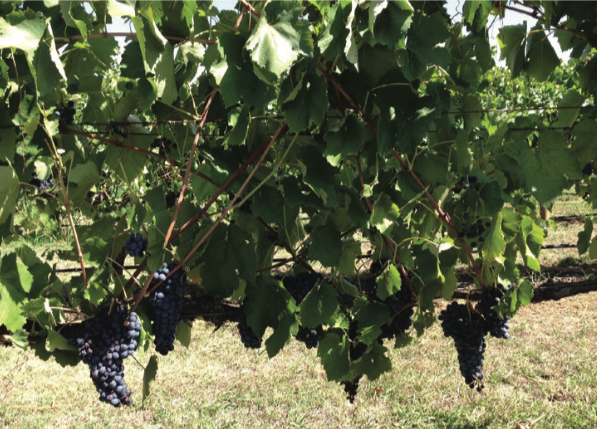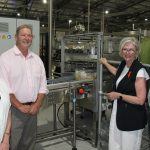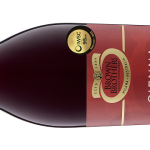By Katherine Brown, Brown Brothers
First published in the September/October 2017 issue of the Wine & Viticulture Journal

 Mondeuse is rarely encountered in Australia although it has been a winemaking grape for centuries. It is believed to have originated in the ancient vineyards of the Savoie, France, as far back as the 10th century. Its wine was used by monks of then newly-established monasteries on the edge of Lake Bouger in this eastern French region. It is also planted in Italy, Argentina and California. The name Mondeuse seems to have been handed down from generation to generation without mention of it being made in writing and the origin of the name seems t o be lost. Because Mondeuse ripens late in the season the vineyards in its homeland are situated to take the greatest advantage of the sun, and even with precaution, there have been seasons when the grapes have failed to ripen.
Mondeuse is rarely encountered in Australia although it has been a winemaking grape for centuries. It is believed to have originated in the ancient vineyards of the Savoie, France, as far back as the 10th century. Its wine was used by monks of then newly-established monasteries on the edge of Lake Bouger in this eastern French region. It is also planted in Italy, Argentina and California. The name Mondeuse seems to have been handed down from generation to generation without mention of it being made in writing and the origin of the name seems t o be lost. Because Mondeuse ripens late in the season the vineyards in its homeland are situated to take the greatest advantage of the sun, and even with precaution, there have been seasons when the grapes have failed to ripen.
MONDEUSE AT MILAWA
Mondeuse was first planted at Brown Brothers’ Milawa vineyard in 1920 when John Francis Brown, the founder of the family vineyard, began replanting it after the devastation caused by phylloxera. He drew on the advice and counsel of Francois de Castella (the state viticulturist, who ran the Rutherglen Research Station at the time) as to which varieties he should plant in the reconstructed vineyard. Francois de Castella saw the climate at Milawa, at the foot of the Victorian Alps, was different than that of the warm and sunny plains around Rutherglen. It was more suited to table wine production than the popular fortifieds of the day.
de Castella encouraged John Brown to concentrate on table wine varieties for the company’s replanting. He had about 100 different table wine varieties in his research vineyard. Grown from cuttings he had taken from European vineyards he had visited in the early years of this century, de Castella had plantings of unheard of varieties like Chardonnay, Cabernet Franc and Mondeuse.
In the mountainous woodlands of the Savoie in France, Mondeuse produces powerfully-flavoured and deeply-coloured wines. In the north-east of Victoria, the warm summers and long lingering autumns gave the variety deep colour and firm tannin. de Castella did not see this as a pr oblem. He recognised these characteristics gave it tremendous keeping qualities, and so dubbed the variety “the Golden Wedding Wine”. It certainly is a wine that offers great cellaring potential. He encouraged John Francis Brown to plant it, telling him that he felt sure it would add to the complexity and flavour of the red wines he produced.
Four acres of the variety were subsequently planted at Milawa. When John Charles Brown joined his father at Milawa in 1933 he also recognised the potential of Mondeuse’s characteristic deep colour and firm tannin. He noted that if he blended Mondeuse with say, Shiraz, the middle palate was given weight and flavour; or with both Shiraz and Cabernet Sauvignon, the palate was given weight, depth and backbone. The complexity and richness that the blend produced was far greater than that of each of the individual components. The Shiraz Mondeuse Cabernet blend that wine lovers have come to know and love was born in 1954. A bottl e of this wine still sits in the Brown Brothers family cellar as a great memory of the winemaking innovation and experimentation of John Charles Brown.
At Milawa the soil and climate have proven to be ideal for the production and ripening of Mondeuse and we find its qualities to be ideal for blending with Shiraz and Cabernet. We find that the resulting wines, while being attractive to drink when young, age extremely well and are a great addition to the cellar, continuing to develop in complexity for five to 10 years and remaining at their peak condition for further time still.
Mondeuse as a single varietal has also been made into a rosé by the Brown Family. Released as a cellar door only wine, this was off-dry in s tyle and proved popular with visitors to Milawa.
The current release of the Brown Brothers Shiraz, Mondeuse and Cabernet is 2013. The vines that produce the grapes for this wine are still planted on the same piece of land that first grew the Mondeuse in 1920. Planted side by side, the Shir az, Mondeuse and Cabernet Sauvignon are picked on the same day each vintage for the ability to co-ferment the three varieties.
The blending of the three grape varieties – Shiraz, Mondeuse and Cabernet Sauvignon – is a tradition unique to Brown Brothers. The blend has almost become synonymous with the Brown family and the Milawa estate and its history is closely intertwined around the company’s own history.
MONDEUSE NOIRE

By Peter Dry Emeritus Fellow, The Australian Wine Research Institute
BACKGROUND
Mondeuse (mon-DERS) Noire is an old variety from eastern France (Isère, Drôme, Hautes-Alpes) that has spread to other countries including Portugal and Switzerland. There is also a Mondeuse Blanche which has a parent-offspring relationship with Mondeuse Noire (as shown by DNA analysis). Therefore, Mondeuse Noire is either a half-sibling or a grandparent of Syrah. This may explain why Mondeuse Noire has been called Grosse Syrah in the Jura, France. Other synonyms include Gros Rouge (Switzerland), Maldoux (Jura), Persagne (Ain), Petite Persaigne (Rhone), Plant Maldoux (Jura), Savoyan (Isère) and Rodo (Portugal). Mondeuse Noire is one of the main varieties used for the appellations of Vin de Savoie and Bugey (Savoie). The global area of Mondeuse Noire in 2010 was 1404 hectares, mostly in France, having increased significantly since 2000. Outside of Europe the largest area may be in California; however, it is difficult to obtain a reliable estimate because Californian statistics do not separate Mondeuse Noire from Refosco dal Penduncolo, even though DNA analysis has shown they are different varieties. In Australia—where it is most often known as just Mondeuse—the planted area is tiny. It is said that, like Durif, it was brought to north-eastern Victoria by Francois de Castella early in the 20th century. Currently, there are at least five wine producers, mainly in central and north-east Victoria.
VITICULTURE
Budburst is early and maturity is mid-season. Vigour is moderate to high. Bunches are medium to large and can range from loose to compact with small to medium berries. Yield is relatively high, comparable with Grenache in Australia. Spur pruning is most often used in both France and Australia. In France, Mondeuse Noire is said to be quite susceptible to mildews; in contrast, it is ‘tolerant’ to mildews in Australia. Susceptibility to drought is high.
WINE
Mondeuse Noire wines are well-coloured, aromatic and tannic with good ageing potential. Descriptors include bitter cherry, dark plum and fruity. In hot climates it has good acid retention. It is often blended with other varieties such as Gamay, Pinot Noir and Poulsard in France; and with Shiraz and Cabernet Sauvignon in Australia.




















